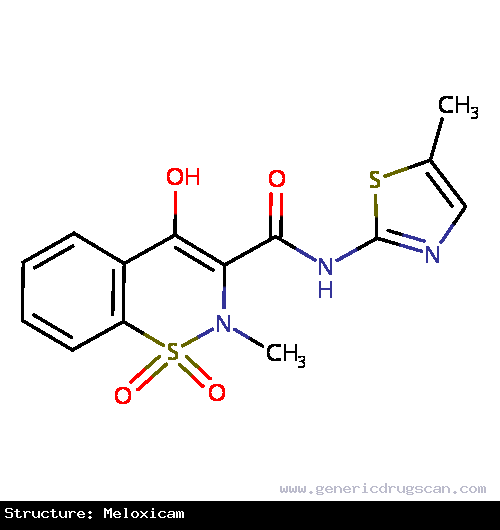Meloxicam Drug: Indication, Dosage, Precaution, Side Effect , Storage, Category Type and corresponding Brands - www.genericdrugscan.com
Meloxicam
Drug Status in USA : ApprovedDrug Status in Canada : Approved
pronunciation
pronounced as (mel ox' i cam)
Why is this medication prescribed?
Meloxicam is used to relieve pain, tenderness, swelling, and stiffness caused by osteoarthritis (arthritis caused by a breakdown of the lining of the joints) and rheumatoid arthritis (arthritis caused by swelling of the lining of the joints). Meloxicam is also used to relieve the pain, tenderness, swelling, and stiffness caused by juvenile rheumatoid arthritis (a type of arthritis that affects children) in children 2 years of age and older. Meloxicam is in a class of medications called nonsteroidal anti-inflammatory drugs (NSAIDs). It works by stopping the body's production of a substance that causes pain, fever, and inflammation.
How should this medicine be used?
Meloxicam comes as a tablet and suspension (liquid) to take by mouth. It is usually taken once a day with or without food. Take meloxicam at the same time every day. Follow the directions on your prescription label carefully, and ask your doctor or pharmacist to explain any part you do not understand. Take meloxicam exactly as directed. Do not take more or less of it or take it more often than prescribed by your doctor.
Shake the suspension well before each use to mix the medication evenly.
What are the precautions to be followed?
Before taking meloxicam,- tell your doctor and pharmacist if you are allergic to meloxicam, sorbitol, aspirin or other NSAIDs such as ibuprofen (Advil, Motrin) and naproxen (Aleve, Naprosyn),any other medications, or any of the ingredients in meloxicam tablets and suspension. Ask your doctor or pharmacist for a list of the ingredients.
- tell your doctor and pharmacist what prescription and nonprescription medications, vitamins, nutritional supplements, and herbal products you are taking or plan to take. Be sure to mention the medications listed in the IMPORTANT WARNING section and any of the following: angiotensin-converting enzyme (ACE) inhibitors such as benazepril (Lotensin, in Lotrel), captopril , enalapril (Vasotec, in Vaseretic), fosinopril, lisinopril (in Zestoretic), and quinapril (Accupril, in Accuretic, in Quinaretic); angiotensin receptor blockers such as azilsartan (Edarbi, in Edarbyclor), candesartan (Atacand, in Atacand HCT), eprosartan (Teveten), irbesartan (Avapro, in Avalide), losartan (Cozaar, in Hyzaar), olmesartan (Benicar, in Azor, in Benicar HCT, in Tribenzor), telmisartan (Micardis, in Micardis HCT, in Twynsta); beta blockers such as atenolol (Tenormin, in Tenoretic), labetalol (Trandate), metoprolol (Lopressor, Toprol XL, in Dutoprol), nadolol (Corgard, in Corzide), and propranolol (Hemangeol, Inderal, Innopran); cholestyramine (Prevalite); cyclosporine (Gengraf, Neoral, Sandimmune); diuretics ('water pills'); lithium (Lithobid); methotrexate (Otrexup, Rasuvo, Trexall); pemetrexed (Alimta); and sodium polystyrene sulfonate products (Kayexalate). Your doctor may need to change the doses of your medications or monitor you carefully for side effects.
- tell your doctor if you have or have ever had asthma, especially if you have frequent stuffed or runny nose or nasal polyps (swelling of the lining of the nose); heart failure; swelling of the hands, feet, ankles, or lower legs; or kidney or liver disease.
- tell your doctor if you are pregnant, especially if you are in the last few months of your pregnancy, you plan to become pregnant, or you are breastfeeding. If you become pregnant while taking meloxicam, call your doctor.
- if you are having surgery, including dental surgery, tell the doctor or dentist that you are taking meloxicam.
- if you have fructose intolerance (an inherited condition in which the body lacks the protein needed to break down fructose
- a fruit sugar found in certain sweeteners such as sorbitol
What are possible side effects of this medication ?
Meloxicam may cause side effects. Tell your doctor if any of these symptoms are severe or do not go away:- diarrhea
- constipation
- gas
- sore throat
- fever
- blisters
- rash
- skin blisters or peeling
- hives
- itching
- swelling of the eyes, face, tongue, lips, or throat
- difficulty breathing or swallowing
- hoarseness
- pale skin
- fast heartbeat
- shortness of breath or difficulty breathing
- unexplained weight gain,
- swelling in the abdomen, ankles, feet, or legs
- nausea
- excessive tiredness
- lack of energy
- yellowing of the skin or eyes
- pain in the right upper part of the stomach
- flu-like symptoms
- cloudy, discolored, or bloody urine
- back pain
- difficult or painful urination
Meloxicam may cause other side effects. Call your doctor if you have any unusual problems while taking this medication.
How to store the medication and dispose it of after its use later?
Keep this medication in the container it came in, tightly closed, and out of reach of children. Store it at room temperature and away from excess heat and moisture (not in the bathroom).
Unneeded medications should be disposed of in special ways to ensure that pets, children, and other people cannot consume them. However, you should not flush this medication down the toilet. Instead, the best way to dispose of your medication is through a medicine take-back program.
Drug Category/Class
- Anti-Inflammatory Agents, Non-Steroidal
- Cyclooxygenase Inhibitors
- Musculo-Skeletal System
- Antiinflammatory and Antirheumatic Products, Non-Steroids
- Antiinflammatory and Antirheumatic Products
- Oxicams
- Cytochrome P-450 CYP2C9 Inhibitors
- Cytochrome P-450 CYP2C9 Inducers
- Cytochrome P-450 CYP2C8 Inhibitors
- Cytochrome P-450 CYP2C8 Inducers
- CYP3A4 Inhibitors
- Oxicams
| Prescribed | For symptomatic treatment of arthritis and osteoarthritis. |
| Weight : | 351.401 |
| Structure | Meloxicam |
 | |
| Formula | C14H13N3O4S2 |
Meloxicam has 39 Brands listed
Search Generic Drugs alphabetically
